A hundred men shoulder a luminous tower through stone streets that have witnessed centuries. Darkness blankets the city, broken only by a monument of light that seems to float. It’s the sacred, surreal, incredible Macchina di Santa Rosa festival in Viterbo. For one night each year, on 3 September, this town 90 km north of Rome, long revered as the city of the popes, becomes a living stage for a one-of-a-kind event.
Faith, artistry, and daring engineering converge in a collective act of devotion. The parade is so unique that UNESCO has recognised it as part of Italy’s intangible cultural heritage. Here’s what you need to know if you want to see it for yourself.
Santa Rosa Machine in Viterbo: A tradition born in the Middle Ages
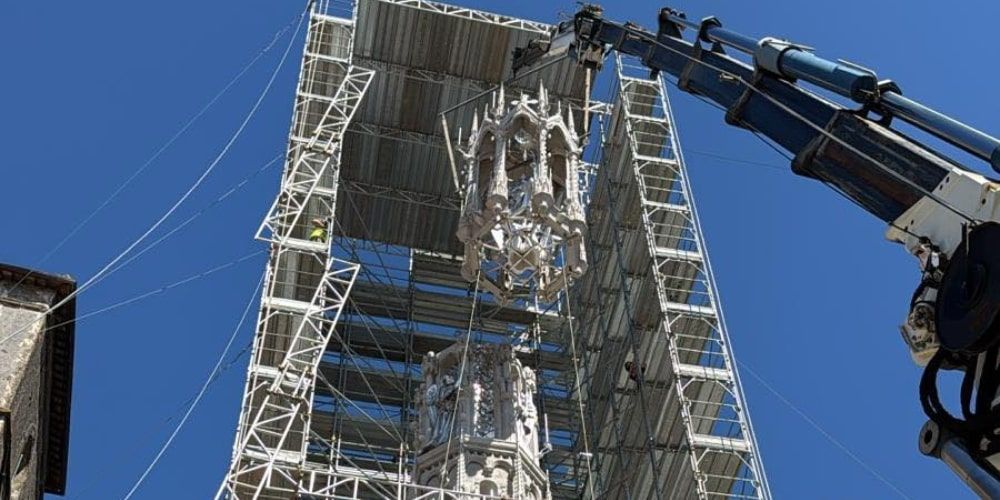
Though Viterbo's Santa Rosa Machine may have changed in appearance over the centuries, its essence remains the same: a community carrying its devotion on its shoulders.
It all began in the thirteenth century, when townspeople started carrying the image of a young woman who died at just 18. Rosa was known for her kindness to the poor and the sick.
After dreaming of her, Pope Alexander IV ordered her body to be moved to the Clarisse monastery in 1258. Miraculously, the remains were still intact seven years after her death. From this event, a tradition began that has only grown stronger.
Today’s religious ritual is a striking and unforgettable spectacle. What used to be a simple canopy for the town’s patroness became something much bigger: tall, illuminated structures called the Santa Rosa Machine, carried through the city by a hundred men.
More on Viterbo's Santa Rosa MachineThe ritual today: who are the Facchini?
The heart of the celebration is the transport of the Machine. Around 100 men, known as the Facchini di Santa Rosa, shoulder the weight of a colossal tower — 30 metres tall, weighing about five tonnes — through the narrow lanes of the historic centre.
The Facchini are volunteers from Viterbo, selected and trained for their stamina and discipline. Months of preparation go into this feat, a demanding physical trial and an act of deep devotion to the city’s patron saint.
Within the group, each man has a role, from those positioned in the inner rows directly beneath the structure (called Ciuffi) to those along the outer edges (Spallette and Stanghette). Dressed in white uniforms with red sashes, they move as one body beneath the steel and wooden base.
The Capo Facchino leads at the front. He calls out every move and makes sure the tower fits through the tightest spots: sometimes there are only eight centimetres to spare.
Before setting off, the bishop gives them a blessing. It is the same prayer used for the dying. That is how serious this is. It reminds everyone how risky the job can be.
The procession lasts more than an hour. Along the route, the Facchini stop at designated squares, resting briefly before lifting the Macchina once more to applause and chants. Each restart is a moment of drama, with the crowd holding its breath until the tower rises steady again.
Macchina di Santa Rosa Festival - A spectacle unlike any other
What makes the Macchina di Santa Rosa festival such a singular event is not only its scale but the atmosphere it creates.
At dusk, all street lights are switched off. The city walls and piazzas are plunged into darkness. Then the tower, studded with hundreds of electric lamps and candles, begins its slow, glowing journey, illuminating the stone facades and the sea of spectators.
The contrast is breathtaking, with the silence broken by collective gasps, bursts of applause, and the rhythmic chants of the Facchini.
Meet the Santa Rosa Machine in Viterbo
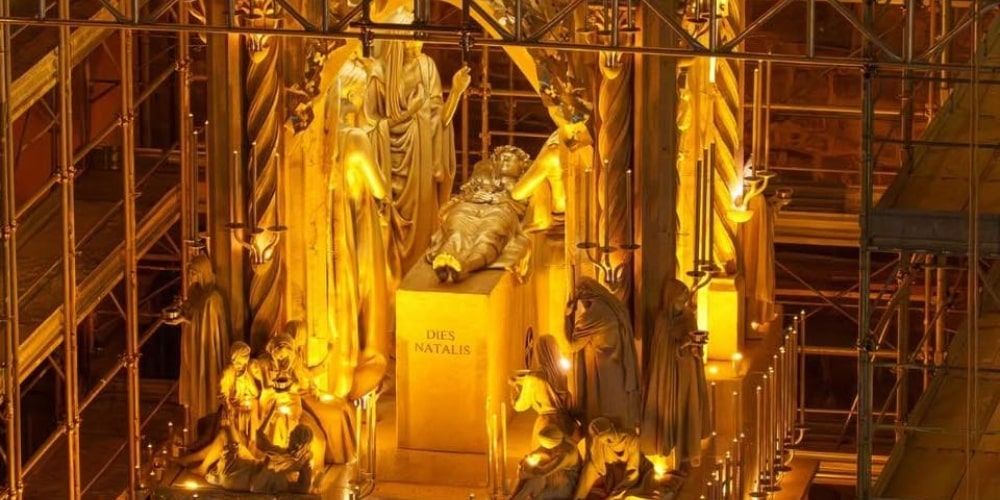
The Macchina, however, is far from static. Every five years, a new design is chosen through a public competition.
The current tower, Dies Natalis (2024), was created by architect Raffaele Ascenzi. The soaring campanile represents three parts of Saint Rose’s spiritual journey: her death, her mystical ecstasy, and, at the top, her encounter with God.
Builders now use modern tools and materials like CNC milling and lightweight aluminum to make the structure (and statue inside) safer and easier to carry.
For visitors seeking to understand the history behind the spectacle, the Museo dei Facchini di Santa Rosa, located in the medieval quarter of San Pellegrino, features scale models of past towers, historic photographs, and videos that chronicle the event's evolution.
. Where to see Viterbo's Santa Rosa Machine up close - After the parade on 3 September, the machine stops for a few days in Largo Facchini di Santa Rosa.
The recognition: among the Italian UNESCO traditions
In 2013, the Santa Rosa Machine was inscribed on the UNESCO Intangible Cultural Heritage List, as part of Italy’s “Celebrations of Big Shoulder-Borne Processional Structures”.
The recognition highlights not just how impressive this celebration looks, but also its role in bringing people together. Festivals like the one in Viterbo rely on everyone pitching in, and they help build a sense of community through working together and respecting each other.
Musicians, singers, and skilled artisans all play a part. People learn by watching and helping, which keeps the tradition alive and strengthens their sense of belonging.
. Did you know? Alongside the luminous tower of Viterbo, the UNESCO list also includes Gigli di Nola, near Naples, Varia di Palmi in Calabria, and Candelieri di Sassari in Sardinia.
Practical tips for attending the Macchina di Santa Rosa festival
If you are planning to see the Santa Rosa Machine in Viterbo for yourself, here are some essentials:
. When to go: the main procession takes place every 3 September at 9 pm, starting from Porta Romana (Piazza San Sisto). The day before, a historical parade with 300 participants in medieval and Renaissance costumes runs from the sanctuary through San Pellegrino to the cathedral.
. Where to stand: the route winds through the walled centre of Viterbo: Via Garibaldi, Piazza Fontana Grande, Via Cavour, Piazza del Plebiscito, Piazza delle Erbe, Corso Italia, Piazza del Teatro, and finally Largo Facchini di Santa Rosa.
. Tickets and seating: most of the route is free. There are a few ticketed seats in Piazza del Comune, plus raised platforms for people with disabilities at Porta Romana, in front of Teatro dell’Unione, and by the porticoes of Palazzo dei Priori. The city shares booking details in August.
. Arrive early: tickets for seats are hard to get, and the streets fill up fast, often by late afternoon. The earlier you arrive, the better your view. Some locals watch from terraces. Ask bars, restaurants, or hotels along the route if you can join them for the event.
. Atmosphere - expect crowds and long waits. Bring comfortable shoes and water. Also, ensure you have sufficient storage space on your smartphone for videos and photos.
. Enhance your visit: stop by Museo del Sodalizio dei Facchini di Santa Rosa in Via San Pellegrino to see scale models, historic photographs, and learn more about this Italian UNESCO tradition.
Why it belongs on your bucket list
A glowing tower that embodies the spirit of a city, the Santa Rosa Machine shows what faith and resilience look like. Standing among thousands in the hushed dark, you feel the anticipation, the strain of one hundred men beneath the weight, the triumphant cheer when the tower rises again.
Of all the Italian cultural festivals, this one is a rare spectacle of devotion and contemporary engineering. It doesn’t matter if you’re there drawn by faith, history, or the sheer drama of human effort; the point is not missing the chance to attend such an uncommon occurrence.
For its combination of artistry, courage, and communal spirit, the legendary Macchina di Santa Rosa has very few equals. And yes, Viterbo’s human tower belongs on your bucket list.
Viterbo is featured in our list of must-see destinations for 2025.
Santa Rosa Machine Viterbo – FAQs
What is the Santa Rosa Machine in Viterbo?
It is a 30-metre illuminated tower, weighing around five tonnes, carried through the streets of Viterbo every 3 September by one hundred men called the Facchini di Santa Rosa.
When does the Santa Rosa Machine festival take place?
The main event is on the evening of 3 September each year. A historical re-enactment parade takes place on 2 September.
How tall is the Santa Rosa Machine?
The current Macchina di Santa Rosa, called Dies Natalis and created in 2024, reaches 33 metres in height.
Is the Santa Rosa Machine festival recognised by UNESCO?
Yes. Since 2013, it has been inscribed on the UNESCO Intangible Cultural Heritage list as part of Italy’s “Big Shoulder-Borne Processional Structures”.
Can tourists attend the Santa Rosa Machine parade?
Absolutely. The event is open to all. Spectators can line the streets for free or book places in grandstands for a better view. Arriving early is strongly recommended.
About the author
Written on 03/10/2025



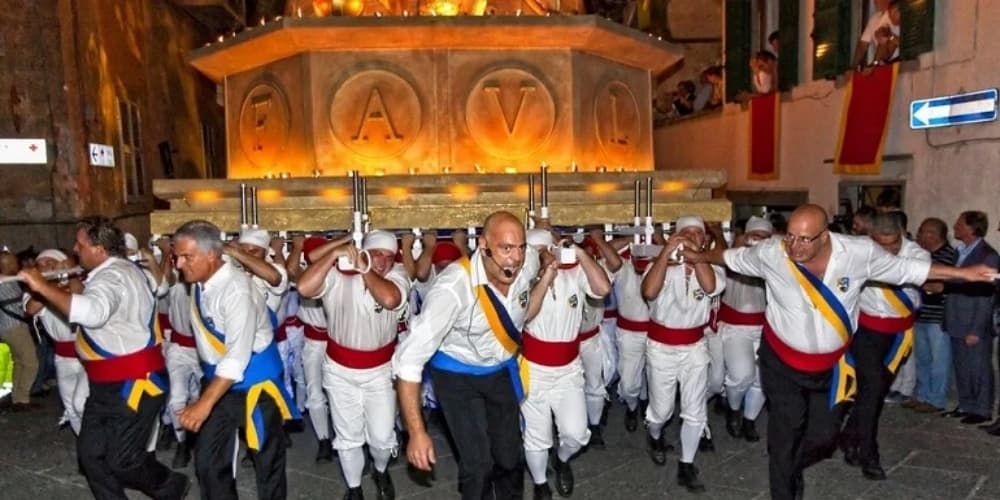

Lorena Calise
100 men, a glowing tower, centuries of devotion, and one magical night. Inside the parade of the Santa Rosa Machine in Viterbo.